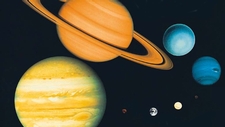Planets
Supporting

TEKS Objective
The student is expected to identify the planets in Earth’s solar system and their position in relation to the Sun.
Essential Understanding
The student knows that there are recognizable patterns in the natural world and among objects in the sky.
Science Background
Lunar and Planetary Science: National Space Science Data Center (website) - Detailed fact sheets and accompanying images for each planet in our solar system.
Lunar and Planetary Science
National Space Science Data Center, nssdc.gsfc.nasa.gov
Solar System: National Geographic (website) - Interactive diagram of the solar system that provides basic information and a sense of distance and physical scale.
Solar System
National Geographic, www.nationalgeographic.com
An Overview of the Solar System: Nine Planets (website) - Tables, pictures and descriptions about the solar system. See the links for each planet at the bottom of the webpage.
An Overview of the Solar System
Nine Planets, www.nineplanets.org
Signature Lesson
Scale Distances in the Solar System: McDonald Observatory (PDF) - Students learn to identify the planets in Earth’s solar system and their relative positions by making a scale model on a strip of paper.
- Supporting Lessons
- Extensions
- Assessment Ideas
- Literature Connections
- Related
TEKS - Additional Resources
Supporting Lessons
Build A Solar System: Exploratorium (website) – Students use an online calculator to create a scale model of the solar system on a roll of toilet paper or a tape measure.
Elaboration Lessons and Extensions
A Scale Model of the Solar System using Play-Doh: NASA (website) - Students shape and arrange balls of Play-Doh into a scale model of our solar system.
A Scale Model of the Solar System using Play-Doh
NASA, www.nasa.gov
Assessment Ideas
Provide students with slips of paper, each with one planet name written on it. Have students arrange the planets in their proper order, starting from the Sun, and at proportionally correct distances.
Literature Connections
Our Solar System (revised edition). Simon S. ISBN: 978-0061140082
Solar System. Vogt G. (ISBN: 978-0545382670)
13 Planets: The Latest View of the Solar System. Aguilar D. (ISBN: 978-1426307706)
Additional Resources
Solar System Size Scale Model Demo: McDonald Observatory (PDF) - Use this downloadable reference sheet to create a demonstration using a basketball, volleyball, etc. to show relative sizes of the planets.
Photojournal: NASA Jet Propulsion Laboratory (website) - Huge collection of downloadable, high-resolution images of the planets.
TEKS Navigation
Grade 3
Need Assistance?
If you need help or have a question please use the links below to help resolve your problem.

Comments
The link to the signature lesson is not working.